After a very busy day today, we returned to our hotel late this evening. It’s about 10:15 PM here, and the dilemma is this: how do I condense an amazing day into a short blog post, not to mention keep it brief enough that I get some sleep instead of staying up all night writing. Let’s see how this goes…
A few minutes ago, my mom asked me what my favorite part of the day was today. I can’t really answer because the whole day was pretty amazing. I had a very powerful experience at one point, but I can’t say that “favorite” is the way to describe it. Different parts of today hit different parts of me: my intellect, my enjoyment of beauty, and of course, my soul.
After breakfast, we began our day by walking part of the way around the walls of the Old City of Jerusalem and entering by the Lion’s Gate. The walls we see today are not the original walls that people in Christ’s time would have seen. Over the years and different conquering forces, they have been destroyed and rebuilt. Some parts are on the original foundations of the previous walls, and other parts are only a few hundred years old. There are 8 gates through the walls around Jerusalem.
For those of you don’t know, I am an ordained Deacon in the Catholic Church. Acts 6 narrates the story of where deacons originate from, including one of my favorite saints: Saint Stephen. Also in chapter 6, we see the beginning of Saint Stephen’s ministry in which members of the Sanhedrin and others were agitated by Stephen’s preaching of the Good News. In Acts 7 Stephen is stoned to death for the Gospel, while Saul (who becomes Paul) stood by. Stephen is the protomartyr of the Church – the first to lose his life after Christ’s resurrection. We celebrate Stephen’s feast day on December 26.
Today, we stood outside the Lion’s Gate and stood on the ground where Stephen was stoned to death. It is a very nondescript place. There were dumpsters nearby, a broken down car, and people coming and going freely. As I stood there, thinking of Stephen, I was deeply moved. Marcellino asked the group to pray over the 4 deacons who are on this trip in that spot. I felt my eyes well up a bit thinking about what Stephen did with such great joy.


Our next stop was the Church of St. Ann – built on the home of Ann and Joachim, the parents of Mary and grandparents of Jesus. (In case you’re curious how we know their names, you can read the Proto-Evangelium of James.) This particular church had been taken over by Muslims and turned into a place of teaching of the Koran. It was restored to a Catholic Church during the crusades. The acoustics in this place were nothing short of spectacular. We sang a short hymn and it was amazing. The echo after we finished reverberated for several seconds before winding down to sacred silence.




A few minutes later we walked about 50 yards to a very interesting place, very close by. It is called Bethesda. In John 5 we hear the story of the ill, blind, lame, and crippled man who had been ill for 38 years. Jesus “knew that he had been ill for a long time”. In the story, the man can’t seem to get into the pool when the water stirs up to be healed. The passage refers to the five porticoes. A 20th century excavation revealed the five porticoes here by the earlier walls of Jerusalem. And it also found the pool area fed by a spring. What struck me is this: how close it was to Jesus’ grandparents’ house. You can see St. Ann’s church in one of the pictures below, just at the top of the stairs out of the portico area. Jesus would have likely known this area pretty well. Although it is speculative, I’m guessing Jesus had seen this man many times over many years as He played near His grandparents’ home. The passage even says that Jesus knew that he was ill for a long time. It took some time before God interceded on this man’s behalf – 38 years of illness. Jesus asks him a simple question: “Do you want to be well?” What happens next is a healing. On God’s time. Be persistent in prayer. God’s time isn’t our time. God’s ways aren’t our ways.
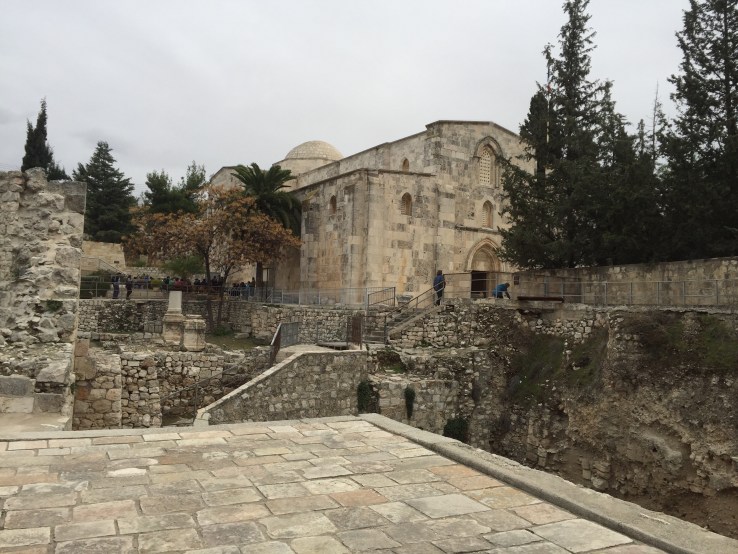
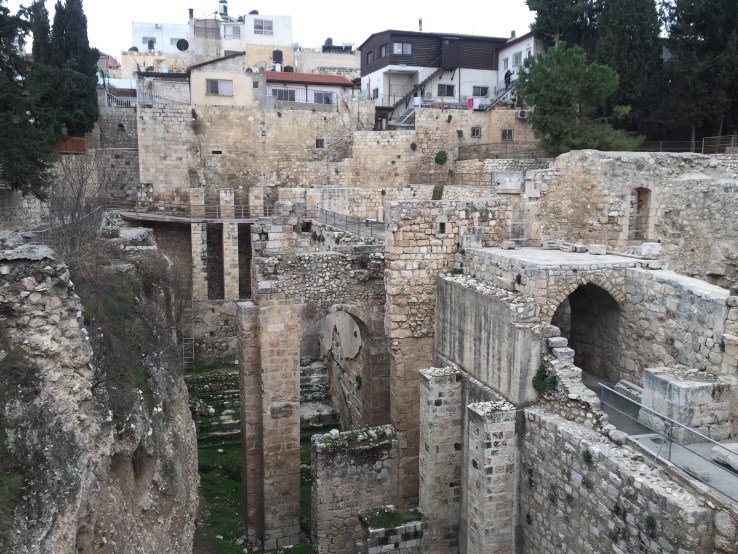


After leaving Bethesda, we went to the Western Wall of the temple. For Jews, this is the holiest place in the world. This is the place you have probably heard of where people come to pray and put prayer requests into the cracks of the wall. I have been carrying prayer requests for others, as well as my own. I put on a kippah (sometimes called a yarmulke) and went the wall to pray. I recited Psalm 63, one of my favorites “O God, you are my God, for you I long, for you my soul is thirsting. My pines for you like a dry weary land without water…”. I prayed for some special intentions and soaked up the experience. I also watched as many young boys made their bar mitzvah by praying the psalms publicly at the wall.

 You can see all of the prayers stuffed into the cracks of the wall next to me (I’m in the brown coat).
You can see all of the prayers stuffed into the cracks of the wall next to me (I’m in the brown coat).

After lunch, our next stop was the National Museum where there is a scale model of Jerusalem before it was destroyed in 70AD. It was fascinating to see how the city was laid out. Jerusalem was much smaller than I had imagined. Our tour guide and Marcellino described the various buildings, the temple, Harod’s palace, the procurator’s palace, the three valleys and so on. My pictures and notes can’t do it justice. Just too much to soak up – really a great learning resource and I hope to be able to return some day to spend more time here. We got scurried out of the museum quickly because the sabbath time was coming close. I would have liked to do more reading and notes … but I guess that’s just part of the experience that will have to wait for the future some day.

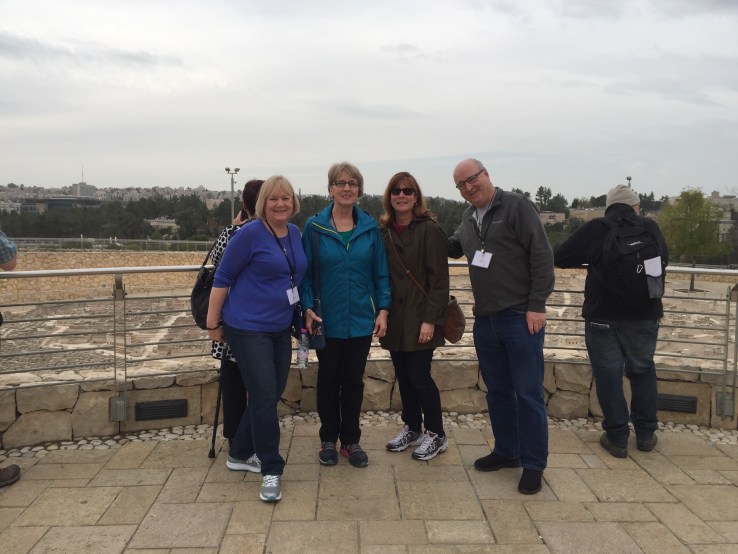





After this, we went to Mount Zion, the place where the Upper Room is. This is where Jesus holds the last supper, institutes the Eucharist, institutes the ministerial priesthood, and gives the Church authority of binding and loosening sins. We made our way up to this place and went inside for a quick visit. There is a sign outside that strictly forbids praying in this area. The upper room is built in an area that is considered to be the tomb of King David (although many modern scholars don’t find this likely any longer), and at one time Muslims turned this room into a prayer room oriented to Mecca before the Crusaders retook the area and turned it back into a church. So with all three major religions having some claim to the area, apparently the answer is to make it a museum instead of a place of prayer. In fact, we had a short prayer over our priests and a guy came in and scolded us for praying there.




The next stop was the Dormition Abbey, just around the corner. According to one major Tradition, Mary slept (died) here before her soul and then body was assumed into heaven. It was very dark inside so the pictures don’t come out well.




At 4PM we had an appointment to say mass at the church of St. Peter in Gallicantu, which is built on the site of the house of Caiaphas, who judged over Jesus during His passion. This is also where Peter denied Jesus three times. The liturgy celebrated today recalls “Peter in tears” from Luke’s gospel when he weeps after denying Jesus. I was blessed to be able to assist at this mass and read this Gospel in such an amazing place.
In the floor of the church is a big hole, about 2-3 feet round. It is the entrance for a large cistern that was then transformed into a maximum security holding cell during the Roman times. This is where Jesus was likely held for at least 1 night before His crucifixion. To get prisoners into this cell, they would put a rope around them and under their armpits. The prisoner would then be lowered into the hole. No other light. No windows. No ventilation. No way out. Absolute darkness. Psalm 88 comes to mind. Excavations have now made this cistern/cell accessible by stairs so we went down below. You can see the hole in the pictures below looking up from the cell.
We also saw the place where Jesus was scourged. This was a very powerful experience.



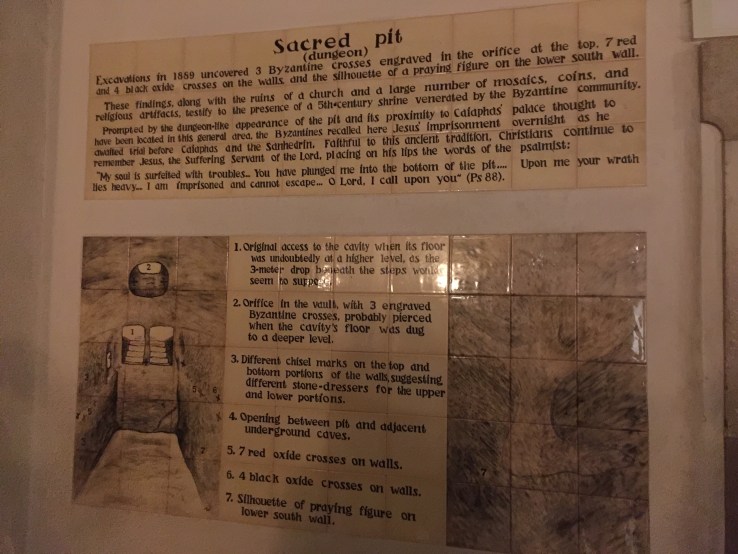


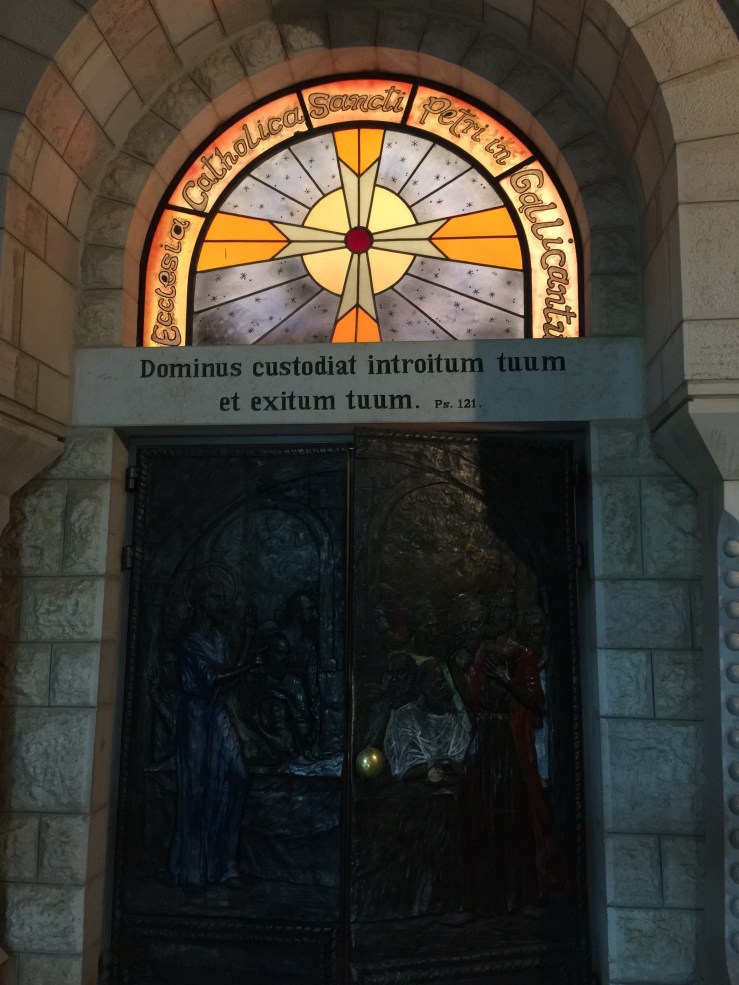
After dinner, we then went to the garden of Gethsemane, where Jesus prayed before His passion and death. I was surprised by how small the area was. The current garden is about 1/3-1/2 acre. Gethsemane roughly means “olive press”. Some of the olive trees in this area are as old as 2000-3000 years old. My eyes looked upon the same trees Jesus saw. Wow.
We then went into the adjacent church where Jesus prayed while the apostles waited nearby. Inside this church is the place where Jesus prayed so fervently that drops like blood fell to the ground. You can see this exposed area in front of the altar below. We had an hour of silent prayer and Adoration before the Blessed Sacrament in this very special place. As jet lag kicked in for several pilgrims, I kept thinking “Couldn’t you stay awake for one hour to pray with me?” In addition to my own intentions, I also prayed fervently that I might not undergo the test – the test of Stephen or of Christ … but more importantly, whatever tests of my own faith that will certainly come my way.
As you leave, you can see the Golden Gate of the walls of Jerusalem. It brings some good perspective on just how close Jesus was when He could see them coming to take Him for the passion.
One nice surprise also – seminarians from the North American College in Rome were also visiting and they provided the sung prayer for our adoration time. I recognized one of them from our home diocese and was able to say hello.


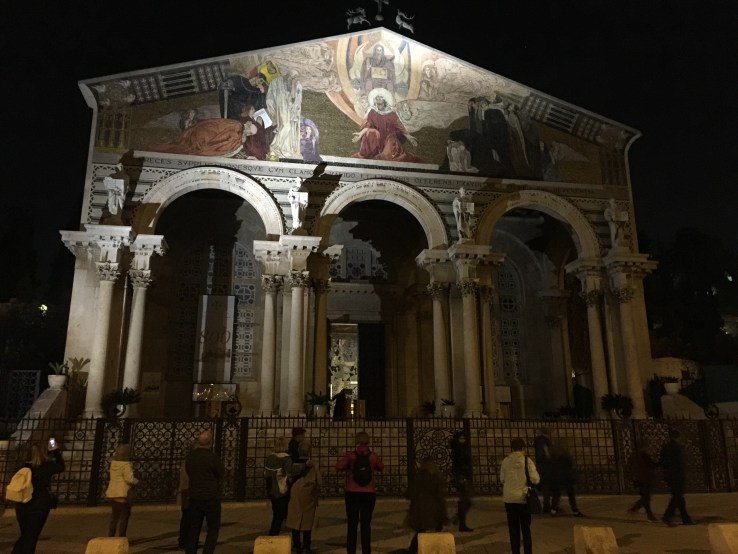
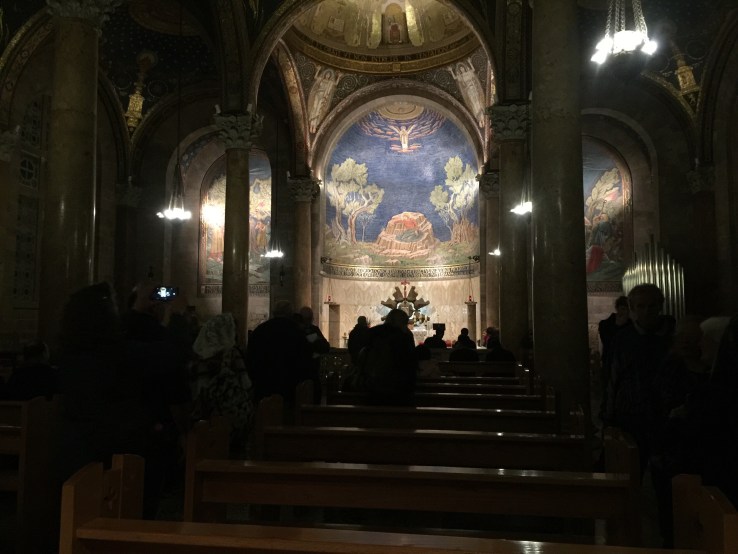


Well, it is far past my bed time. Tomorrow is another busy day in the mountains of Jerusalem.
Shalom,
Deacon Matt

Bringing back memories!! Thanks!
The Rosary will never be the same for you!!
Thanks, Matt!
Thanks for sharing this, Matt! Awesome!
What an amazing day! Give mom a hug.
[…] Israel Day 2 – The Old City of Jerusalem. […]